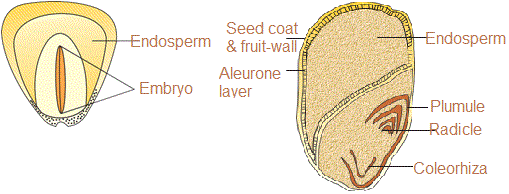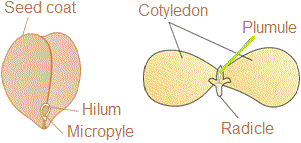Seed in plant
The ovules after fertilisation, develop into seeds. A seed is made up of a seed coat and an embryo.
The embryo is made up of a radicle, an embryonal axis and one (as in wheat, maize) or two cotyledons (as in gram and pea).
Types of Seeds
The Seed is primarily of two types as follows:
| MONOCOT | DICOT |
 |
 |
Structure of Monocot Seed
The monocotyledonous seed, has only one cotyledon. There is only one outer layering of the seed coat and seed has the following parts:
| Seed Coat | In the seed of cereals such as maize, the seed coat is membranous and generally fused with the fruit wall, called Hull. |
| Endosperm | The endosperm is bulky and stores food. Generally, monocotyledonous seeds are endospermic but some as in orchids are non-endospermic. |
| Aleuron layer | The outer covering of endosperm separates the embryo by a proteinous layer called aleurone layer. |
| Embryo | The embryo is small and situated in a groove at one end of the endosperm. |
| Scutellum | This is one large and shield-shaped cotyledon. |
| Embryonal axis | Plumule and radicle are the two ends. |
| Coleoptile and coleorhiza | The plumule and radicle are enclosed in sheaths. They are coleoptile and coleorhiza. |
Structure of Dicot seed
The dicotyledonous seed, has two cotyledons and has the following parts:
| Seed coat | This is the outermost covering of a seed. The seed coat has two layers, the outer testa and the inner tegmen. |
| Hilum | The hilum is a scar on the seed coat through which the developing seed was attached to the fruit. |
| Micropyle | It is a small pore present above the hilum. |
| Embryo | It consists of an embryonal axis and two cotyledons. |
| Cotyledons | These are often fleshy and full of reserve food materials. |
| Radicle and plumule | They are present at the two ends of the embryonal axis. |
| Endosperm | In some seeds such as castor, the endosperm formed as a result of double fertilisation, is a food storing tissue. Examples are bean, gram and pea, the endosperm is not present in the matured seed. They are also known as non-endospermous. |

(Structure of Monocot)

(Structure of Diocot)
Properties of seeds
Structural and geometrical properties such as :
Mass, shape, volume, density, particle size, length, location, porosity, surface roughness and cellularity.
